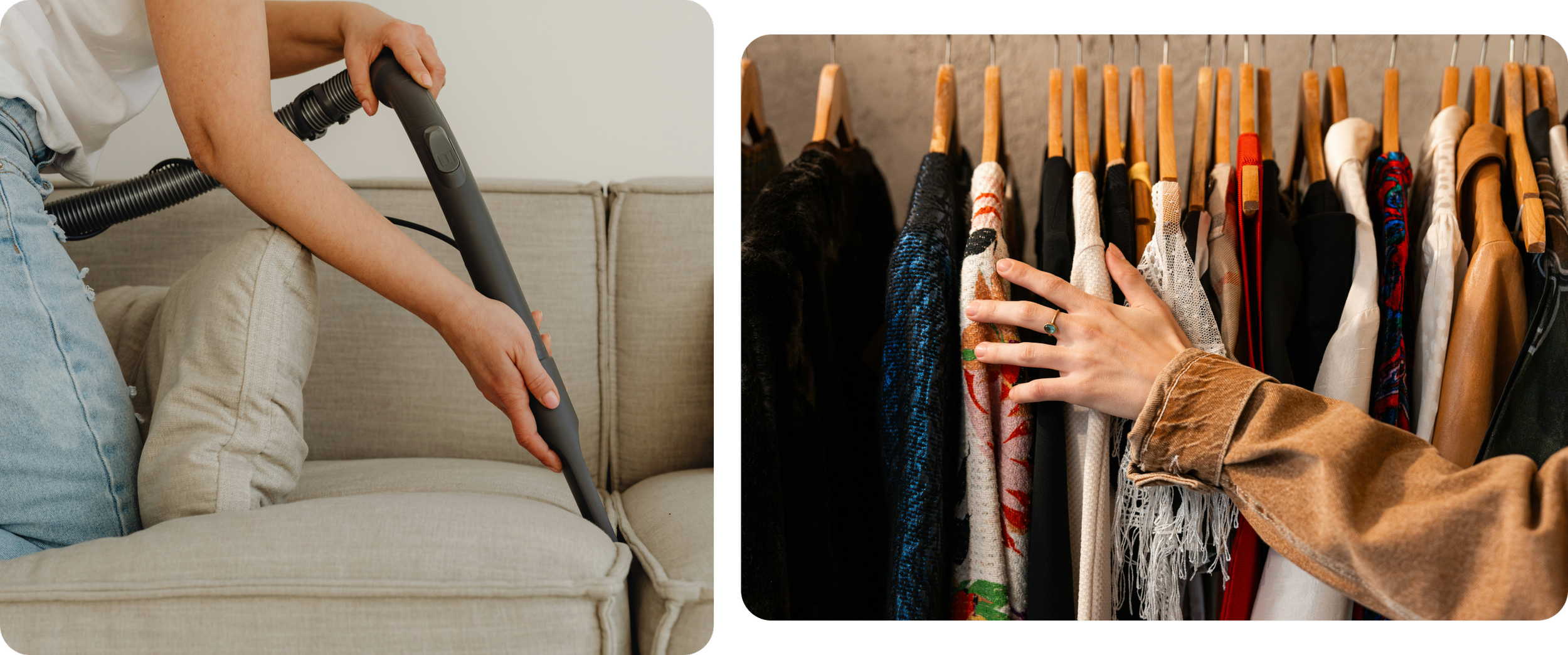Breathe Easy: 5 Ways to Reduce Microfiber Exposure in Your Home
Breathe Easy: 5 Ways to Reduce Microfiber Exposure in Your Home
Author: The 5 Gyres Institute
When you think of plastic pollution, you might picture single-use plastic bottles, bags, and cutlery littering coastlines, waterways, and even national parks. However, a bigger threat is the plastic pollution we can’t see: microplastics.
One of the most common types of microplastic pollution in the ocean is textile fragments. Why? Most clothing today is made of plastic-based fibers, like spandex, nylon, and polyester, which shed tiny fibers every time they’re worn, washed, and dried.
Those tiny shedded fibers are called microfibers, and can also come from carpets, curtains, and other household items, making our homes a hotspot for airborne microfiber pollution. These microfibers can enter the air we breathe and the water we drink, and they have even been found in the human body. Fortunately, there are simple steps you can take to reduce exposure in your home.
1. Wear and wash items wisely
Avoid synthetic clothing fabrics and opt for natural fibers, such as cotton, hemp, and wool whenever adding new items to your closet. When it comes to the synthetic fabrics you already own, try washing them less frequently, since garments shed microfibers every time they’re washed and dried. In fact, 18 million microfibers can be released from a single wash cycle! You can also install a microfiber-catching filter to your washer and adjust your machine washing settings. Washing full loads with cold water can significantly reduce fiber shedding.
Microfibers are also released into the air as you tumble dry. Your dryer’s lint trap is proof of how many microfibers are shed during a single cycle. Opt for air drying instead — it saves energy, and prolongs the life of your clothing. Lint rollers can catch any visible loose microfibers (aka lint).
2. Shop secondhand
Fast fashion and cheaply made textiles shed more than well-made fabrics, and the highest amount of shedding is usually in the first several washes. By thrifting or buying secondhand, you not only save money and reduce waste, but also bring home clothing that has already “pre-shed” most of its microfibers. Win-win.
Just avoid items like brushed polyester blankets and unhemmed clothing, which are some of the worst microfiber culprits.
3. Choose home goods with natural materials
Microfibers don’t just come from clothing – carpets, curtains, and upholstered furniture are common sources too. Whenever possible, opt for rugs made of natural fibers like wool or jute. For upholstery, consider natural textiles such as organic cotton or hemp.
Remember: Sustainable living doesn't have to be expensive. Many home items can be bought secondhand, or you can join a local “Buy Nothing” group where members of your city trade or give away high-quality items they no longer have use for.
4. Keep it clean
A dust-free home is a microfiber-free home. Dust particles can carry various pollutants, including microfibers, forever chemicals, and even pesticides, which settle in carpets and on furniture. Just sitting on your couch can send these particles airborne. Regular dusting and vacuuming can help keep your home, and air, free of microfibers.
5. Spread the word, at home and elsewhere
Share these tips with your family members, so they can start reducing microfiber exposure at home too. And keep in mind, reducing microfiber pollution starts at home, but it doesn’t have to stop there.
Join 5 Gyres’ #DoLessForThePlanet campaign and take the pledge to commit to small lifestyle changes that lead to big environmental benefits. Then, share the pledge with more people in your circle! Every small action contributes to the larger goal of protecting our oceans, air, and soil from the harmful effects of plastic pollution.
For more tips, check out 5 Gyres’ Guide to Reducing Microfiber Pollution at Home.
While individual action is important, scientific research is vital to drive long-term solutions to microfiber pollution. 5 Gyres is currently studying microfiber emissions from different sources, including dryers, carpets, and upholstery, to understand the scale of microfiber emissions and develop effective solutions. Consider supporting this important work by donating today.
This blog provides general information and discussions about health and related subjects. The information and other content provided in this blog, website, or in any linked materials are not intended and should not be considered, or used as a substitute for, medical advice, diagnosis, or treatment. Always seek the advice of your physician or other qualified health care provider with any questions you may have regarding a medical condition or treatment and before undertaking a new health care regimen, and never disregard professional medical advice or delay in seeking it because of something you have read on this website.


